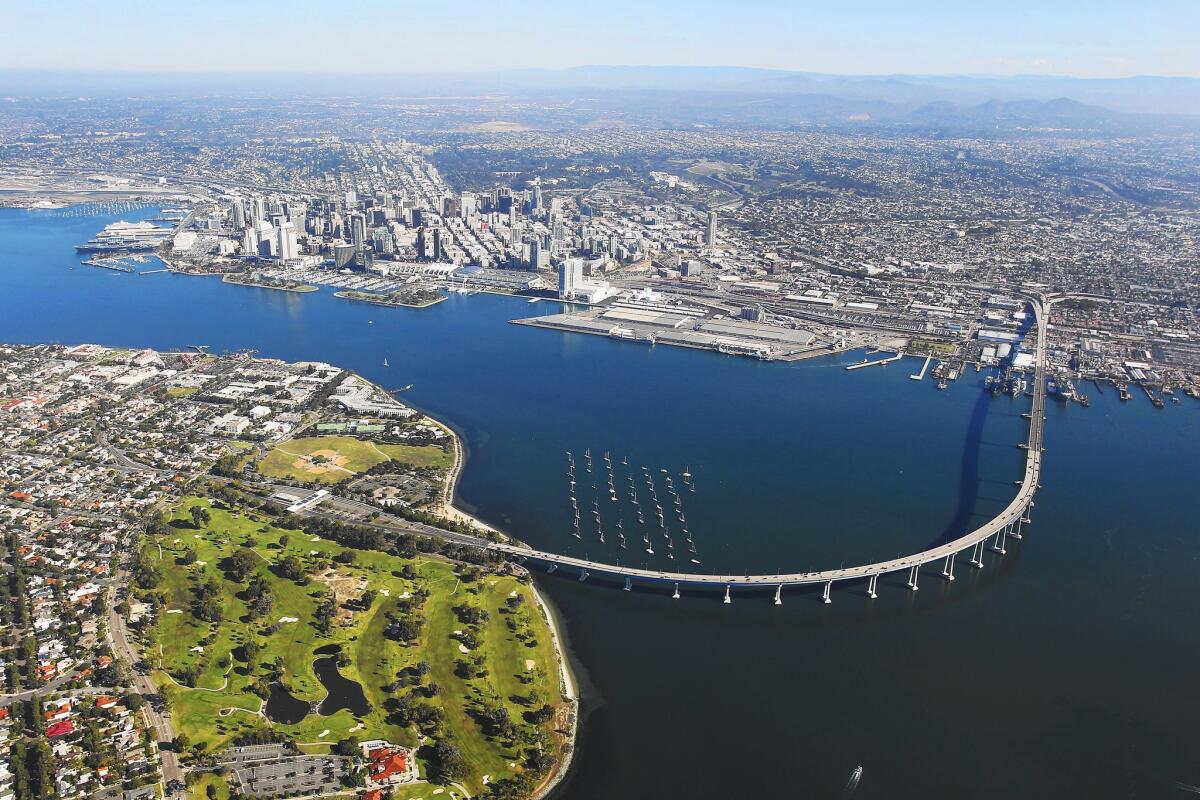Ambitious bike lanes for Coronado Bridge would cost $210 million

Would you like to ride a bike or walk across the 2.1-mile Coronado Bay Bridge and enjoy the views at your own pace?
A report headed for a San Diego Assn. of Governments committee Thursday says the concept — dreamed of even before the bridge opened in 1969 — contains no “fatal flaws” except perhaps this one:
It could cost as much as $210 million and might require bringing back toll charges that ended 15 years ago.
San Diego County Supervisor Greg Cox, a longtime champion of a bikeway circling San Diego Bay, said the cost was about four times what he originally expected and he will now leave it to others to pursue the idea as money becomes available.
“It was really just an opportunity to look at possible alternatives,” Cox said. “I think, based on the study we’ve done here, it’s good, useful information.”
As for bringing back the $1-per-car bridge toll, Cox did not endorse a new toll or a specific amount. But he thought any such idea would be a “hard sell,” especially in Coronado, and that perhaps cyclists and pedestrians should be charged instead just as they are on other bridges around the world.
The San Diego Assn. of Governments’ Bayshore Bikeway Working Group will meet at 2 p.m. Thursday at the association’s downtown office to review the 66-page feasibility report. Since the report will be presented as an “information item,” no official action can be taken but the group can place an “action item” on a future agenda.
Funded by a $75,000 county grant, the study was conducted by architectural firm HNTB and outlined three ways to cross the bridge on bike or feet:
Build a tube through the bridge’s arch supports and include observation decks on the north and south sides. The tube would be 15 feet in diameter with the interior height at 8 feet and the riding/walk surface 10 feet wide.
Locate the tube alongside the top of the bridge piers, just below the riding surface. But the tube would be on only the north or south side, leaving users no chance to experience the opposite view. And the bridge painting and maintenance equipment system would have to be relocated.
Add the tube at the same level as the driving deck. But this might impede the view enjoyed by motorists on the side of the bridge where the tube is located.
Navy and Caltrans officials raised various issues in comment letters, such as blocked passage of Navy ships between two of the central piers in addition to security and safety concerns. Caltrans said 13 agencies would have some say in permits and permission.
Cox, who was in high school when the bridge was being designed in the early 1960s, said the bridge was narrowed as a cost-saving measure, which may explain why pedestrian and bike lanes were never included. Over the years, many people have lobbied to retrofit the bridge to complete a bikeway around the entire bay and Cox persuaded his fellow county supervisors to commission the study.
The tube concept was advanced by retired architect Lew Dominy and the good news, according to the study, is that the bridge can be structurally modified. But as Caltrans said in its comment letter, the bridge will become historic in 2019 and a visual impact analysis is needed to determine whether the original sleek, award-winning look would be diminished.
Another concern was whether the 195-foot clearance could be retained for Navy ships and cargo traffic. One of the passages would not be clear because the tube would have to be lowered 30 feet to meet accessibility standards for the disabled. Cox said the tube could be routed around the affected piers to avoid that problem.
But cost appears to be the biggest impediment.
“It is a big number and there are clearly going to be higher priority projects,” Cox said. “This is not going to cut in front of anybody.”
ALSO
L.A. City Hall critic faces charge of possessing an assault weapon
Mexican state attorney general arrested at U.S. border in San Diego on drug trafficking charges
More to Read
Sign up for Essential California
The most important California stories and recommendations in your inbox every morning.
You may occasionally receive promotional content from the Los Angeles Times.










